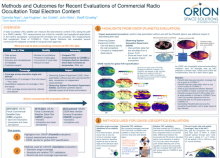Methods and Outcomes for Recent Evaluations of Commercial Radio Occultation Total Electron Content
Camella
Nasr
Orion Space Solutions
Poster
Global Navigation Satellite System (GNSS) Radio Occultation (RO) is a remote sensing technique that uses GNSS signals of opportunity to estimate parameters of the Earth’s atmosphere such as the total electron content (TEC). Currently, near real time RO measurements are provided by the COSMIC-2 mission and an increasing number of commercial providers. The data available from commercial providers has significant scientific and operational potential, especially given their coverage of higher latitudes that are not visited by COSMIC-2. Orion Space Solutions (OSS) has a long history of evaluating commercial RO data utility, from Spire, GeoOptics, and PlanetiQ. As part of the US Air Force’s Commercial Weather Data Pilot (CWDP), we assessed the quality of ionospheric TEC data collected by PlanetiQ’s GNOMES-2 satellite beginning in late 2021. We investigated quality with respect to the elevation angle, minimum altitude, geographic coverage, and receiver performance statistics, comparing those to COSMIC-2 and other commercial providers. The data was also compared to ionosondes, incoherent scatter radars (ISRs), the international reference ionosphere (IRI) climatological model, and an assimilative model: IDA4D. We performed an Observing System Simulation Experiment (OSSE) to compare the resulting analysis to the original truth model. In all aspects of overall data evaluation, PlanetiQ data was found to be accurate and high quality. For NASA’s Commercial Smallsat Data Acquisition New Vendor Onramp Evaluation (CNVOE) program, we evaluated whether GeoOptics ionospheric data supports NASA’s earth science research goals. We will present several methods and outcomes of these past and current evaluations.

Poster PDF
Poster category
Ionosphere and Thermosphere Research and Applications
Poster session day
Poster location
7
Meeting homepage